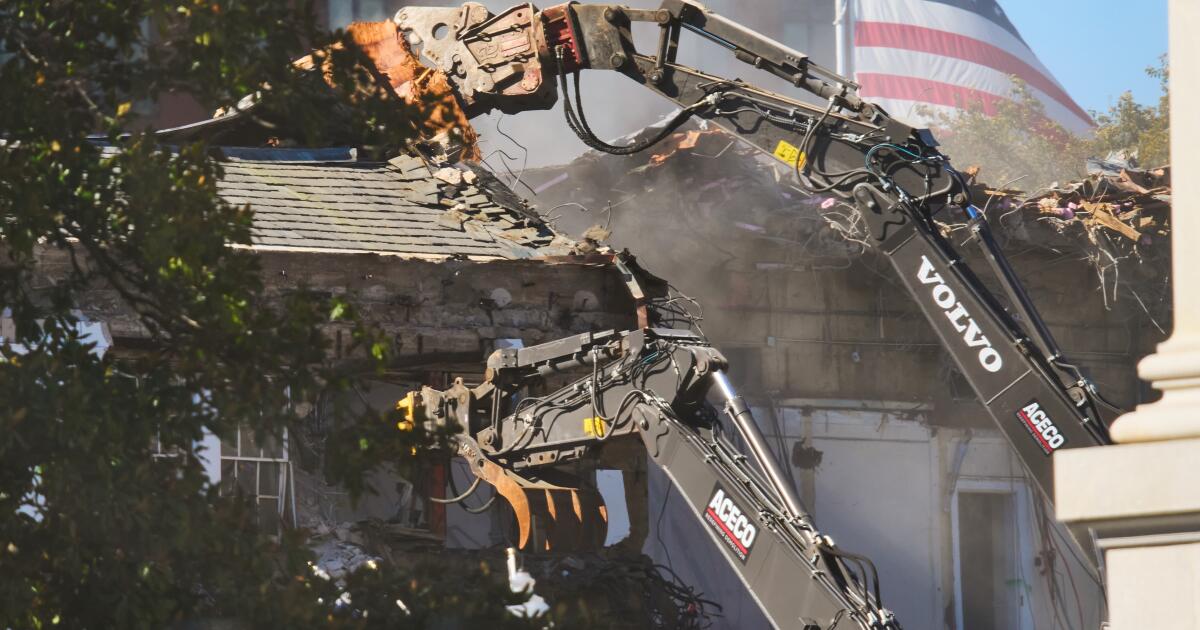The Trump administration is forging ahead with a plan that is sure to fuel alarm across California’s immigrant communities: handing over the personal data of millions of Medicaid recipients to federal immigration officials who seek to track down people living in the U.S. illegally.
The huge trove of private information, which includes home addresses, social security numbers and ethnicities of 79 million Medicaid enrollees, will allow officials with Immigration and Customs Enforcement greater latitude to locate immigrants they suspect are undocumented, according to an agreement signed this week between the Centers for Medicare and Medicaid Services and the Department of Homeland Security and obtained by the Associated Press.
“ICE will use the CMS data to allow ICE to receive identity and location information on aliens identified by ICE,” the agreement says.
The plan, which has not been announced publicly, is the latest step by the Trump administration to gather sensitive information about people living in the U.S. as it seeks to deliver on its pledge to crack down on illegal immigration and arrest 3,000 undocumented immigrants a day. It is certain to face legal challenges.
Critics have sounded the alarm ever since the Trump administration directed the CMS last month to send the DHS personal information on Medicaid enrollees, including non-U.S. citizens registered in state-funded programs in California, Illinois, Washington and Washington, D.C.
These states operate state-funded Medicaid programs for immigrants who are otherwise ineligible for federal Medicaid and had committed not to bill the federal government.
California Senators Alex Padilla and Adam Schiff warned last month of potential violations of federal privacy laws as Trump officials made plans to share personal health data.
“These actions not only raise ethical issues but are contrary to longstanding HHS policy and raise significant concerns about possible violations of federal law,” the Senators wrote in a letter to U.S. Health and Human Services Secretary Robert F. Kennedy Jr., DHS Secretary Kristi Noem and CMS Administrator Mehmet Oz.
“We are deeply troubled that this administration intends to use individuals’ private health information for the unrelated purpose of possible enforcement actions targeting lawful noncitizens and mixed status families,” Padilla and Schiff said in a statement. “The decision by HHS to share confidential health information with DHS is a remarkable departure from established federal privacy protections that should alarm all Americans.”
DHS spokesperson Tricia McLaughlin declined to answer questions about whether immigration officials are now accessing the personal Medicaid data or how they plan to use it.
“President Trump consistently promised to protect Medicaid for eligible beneficiaries,” McLaughlin said in a statement. “To keep that promise after Joe Biden flooded our country with tens of millions of illegal aliens CMS and DHS are exploring an initiative to ensure that illegal aliens are not receiving Medicaid benefits that are meant for law-abiding Americans.”
Undocumented immigrants are not permitted to enroll in Medicaid, a joint federal and state program that helps cover medical costs for low-income individuals. The program also limits benefits for other lawfully present immigrants, with some required to undergo waiting periods before they can receive coverage.
However, federal law requires states to offer emergency Medicaid, coverage that pays for lifesaving services in emergency rooms to everyone, including non-U.S. citizens.
A 2024 Congressional Budget Office report found that a total of $27 billion was spent on emergency Medicaid for non-citizens between 2017 and 2023. That number represents less than 1% of overall spending on Medicaid during that time period. Nevertheless, Trump and other federal leaders have pushed to reduce spending on Medicaid, alleging that undocumented immigrants have been taking advantage of the program.
Hannah Katch, a CMS advisor during the Biden administration who previously worked for California Medicaid, told The Times that the Trump administration’s plan to turn over Medicaid data represented “an incredible violation of trust.”
The data that states send to CMS has certain protections and requirements in statute and also by custom, Katch said. For CMS to share the information of Medicaid enrollees outside the agency, she said, would have a devastating impact on people who depend on emergency Medicaid to access critical care.
“Making people afraid to seek care when they are experiencing a medical emergency, or when their child is experiencing a medical emergency, it is an incredibly cruel action to take,” Katch said.
Elizabeth Laird, the director of equity in civic technology at the Center for Democracy & Technology, said the sharing of such data would further erode people’s trust in government.
“By turning over some of our most sensitive healthcare data to ICE, Health and Human Services has fundamentally betrayed the trust of almost 80 million people,” she said in a statement to The Times.
“This jaw-dropping development proves that the Administration’s claim of using this information to prevent fraud is a Trojan horse that instead will primarily advance their goal of deporting millions of people,” she said. “Over 90 percent of entitlement fraud is committed by U.S. citizens, underscoring the false pretense of sharing this information with ICE.”
The plan to share Medicaid data is not the first time the Trump administration has sought to share personal information across departments. In May, the Department of Agriculture told states they had to turn over data on the recipients of SNAP food benefits.
Last month, the California Medical Assn. warned that the Trump administration’s sharing of personal Medicaid data would put nearly 15 million patients and their families at risk statewide.
Dr. René Bravo, CMA’s president elect, said that sending sensitive patient information to deportation officials “will have a devastating impact on communities and access to care that all people need.”
“Our job is not protecting the borders, it’s protecting our patients and providing the best health care possible, “ Bravo said in a statement. “When patients come to us it’s often the most vulnerable times in their lives, and we offer a safe space for their care.”
Orange County’s Office of Immigrant and Refugee Affairs notified the public last month that the CMS had been directed to send DHS personal information of Medicaid enrollees, including non-citizens.
“This data, provided for the purpose of administering healthcare, may now be used to locate individuals for immigration enforcement or to challenge their future immigration applications,” the statement read.
The agency wrote that it had already heard of increased anxiety among clients who are fearful that their personal information could be used against them if they seek health care services.
“We are concerned this will further erode trust in public institutions and care providers,” the agency wrote.
Orange County Supervisor Vicente Sarmiento, who represents a large Latino population that includes Santa Ana and portions of Anaheim, said the families enrolled in Medi-Cal did so with the reasonable expectation their information would be kept private.
He called the action a “cruel breach” that erodes people’s trust in government.
“These actions discourage participation in healthcare and mean that some individuals may not seek needed medical services,” he said in a statement. “This hurts the overall community, creates serious public health concerns, and increases costs for our healthcare system.”
Jose Serrano, director of Orange County’s Office of Immigrant and Refugee Affairs, said certain information about those who sign up for benefits has long been shared with the state, which passes it along to the federal government for research, funding and eligibility purposes.
“The one thing that is different during this time is that the information is being used against people, especially those who are immigrants,” he said.
The situation has already caused anxiety among immigrant populations in Orange County, Serrano said. Some have reached out to the agency asking whether they can un-enroll from programs or change their addresses for fear that they or their families may be targeted by immigration officials.
“The truth is immigrants spend more and invest more in our communities and the economy then they take away,” Serrano said, adding that it’s unfortunate that this medical information is “going to be used against the same families that are already investing in our communities through the taxes they pay on a yearly basis.”










